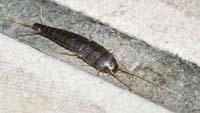Insects could develop ground wings

The journal Biology Letters has announced that the conclusions of a study carried out in Peru suggest the appearance on land of winged insects.
The analysis of the behavior of silver fishes - primitive insects without wings - has shown that they use elongators in the form of antennas to plan and, in some way, in situations of risk of control of the fall, when they are thrown from some tree for example.
Based on the fossil record, experts believe that 390 million years ago, insects similar to those of silver fishing, insects without wings and with six legs predominated. However, they do not know how and where these insects evolved to become wings. And there is a great lack of fossil, the oldest fossils they know 390 million years ago and those known 325 million years ago. And by then there were already winged insects.
Scientists are faced with two main hypotheses: one says that the wings were developed from the protuberances of insects that lived in the water, and the other, from the lateral extensions of the terrestrial insects.
The group that has worked the article took about 200 plates and divided them into six groups. They left a group without touching, as control, and the others were removed one or another strand of their body, letting them fall down by a tree. They observed that most of the intact insects somehow controlled the passage to land, and that those who were missing long had greater difficulties.





